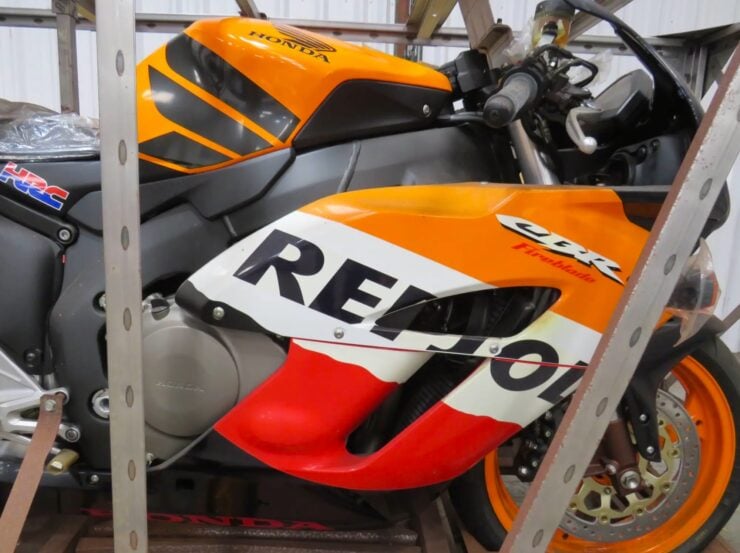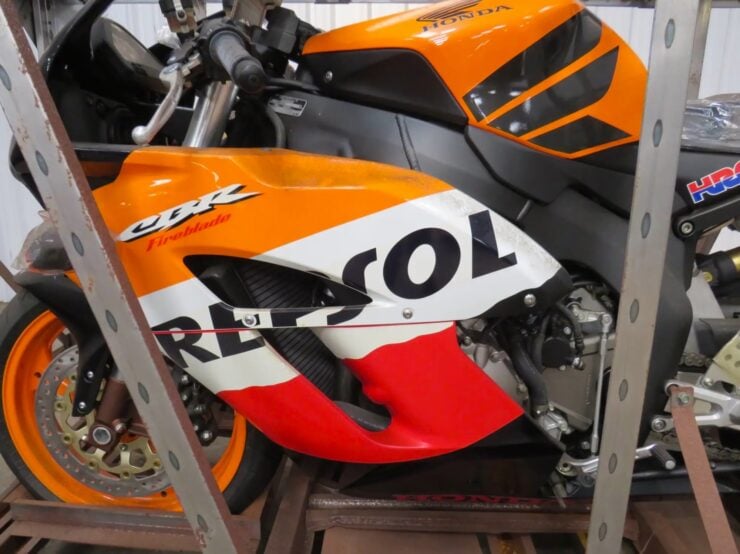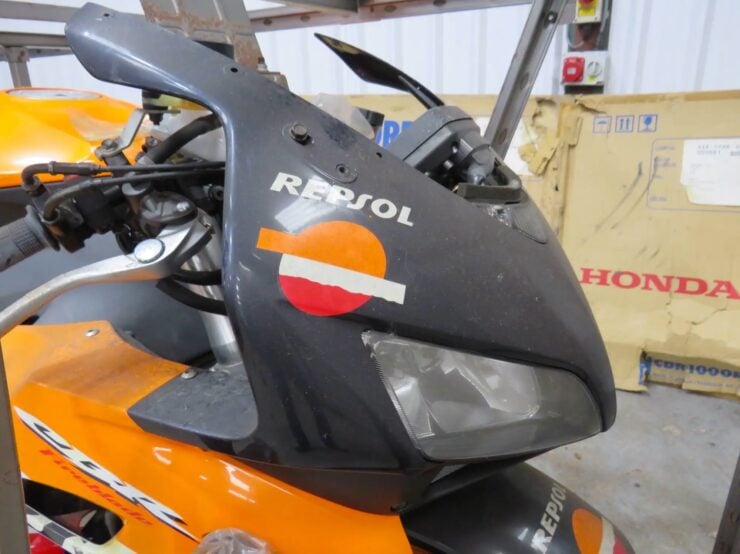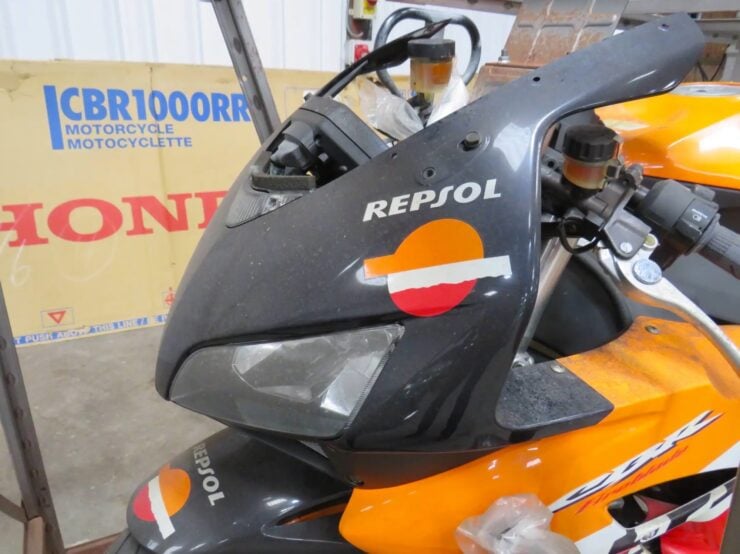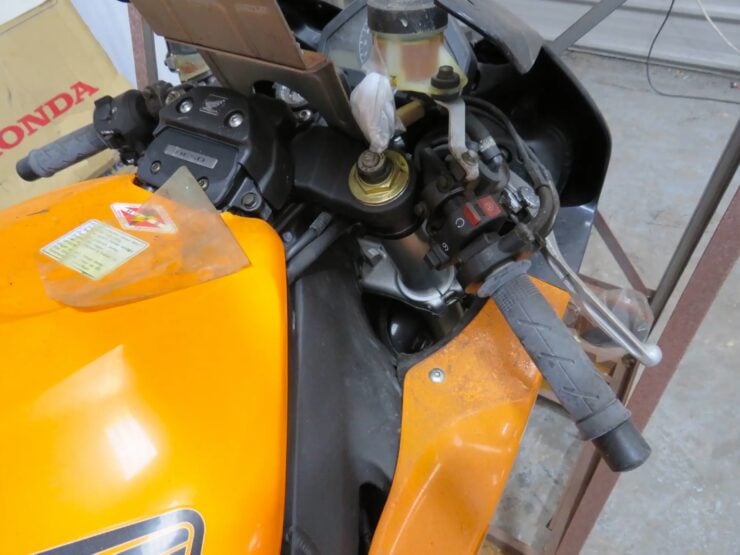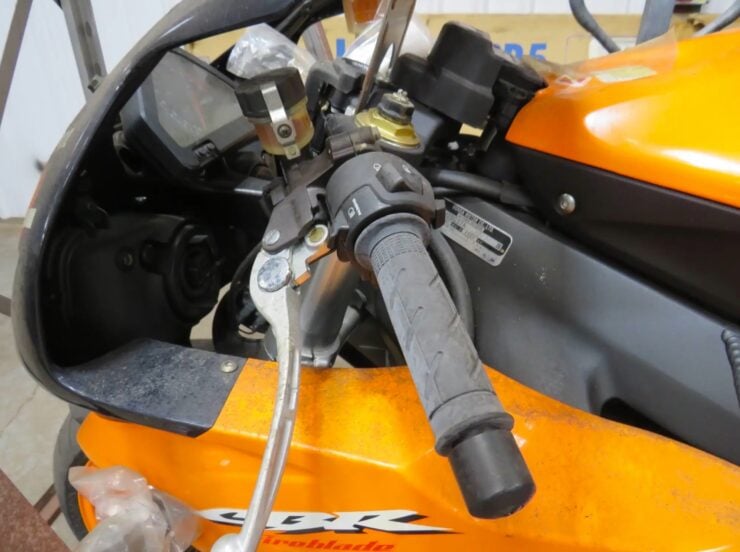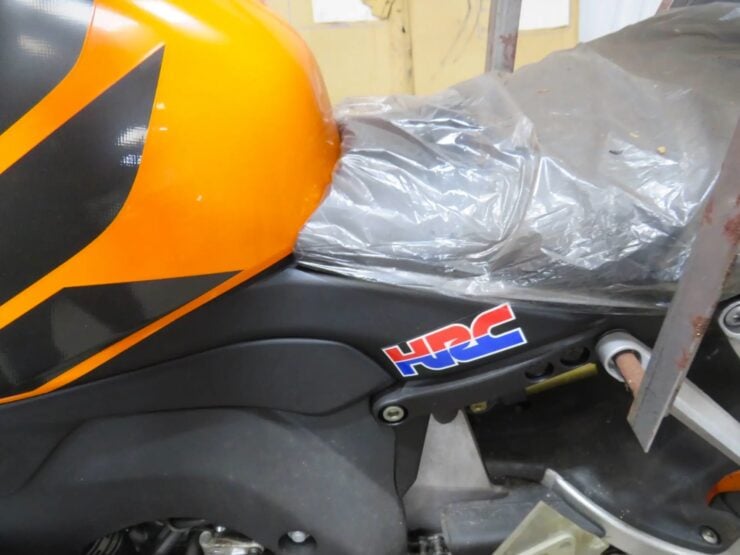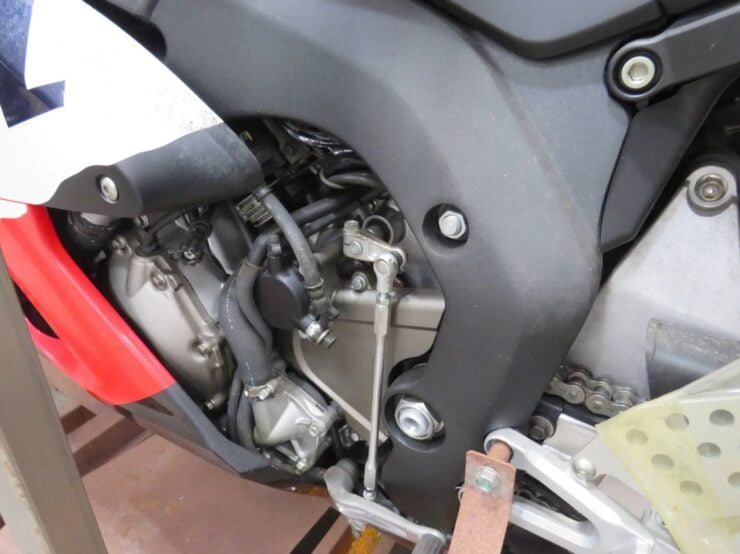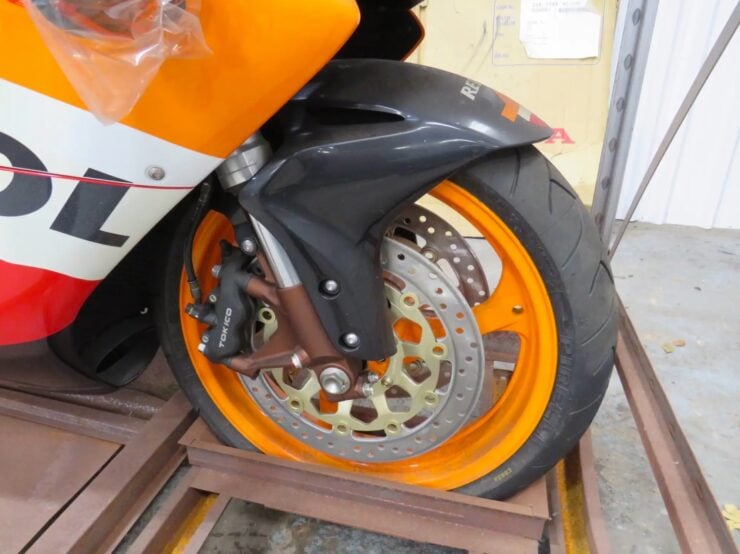This is a Honda Fireblade CBR1000RR SC57 from 2005 that has been left in its original factory crate for the last 20 years and counting – having never been ridden.
It’s likely the last new Fireblade of this vintage available anywhere in the world, except maybe the Honda Museum in Japan, and it’s now being offered for sale. The “Fireblade” name was chosen as it’s an almost exact translation of the Japanese word for “lightning,” and anyone who’s ever ridden one can attest to the appropriateness of the moniker.
Fast Facts: A Still-Crated Honda Fireblade
- This 2005 Honda CBR1000RR Fireblade has remained untouched in its original factory crate for over two decades, making it possibly the last of its kind in new condition outside of Honda’s museum. Originally dealer stock, it is now being auctioned with its key components still boxed and unopened.
- The Fireblade lineage began in 1992 with the CBR900RR, engineered by Tadao Baba to prioritize lightness and agility over outright power. It redefined superbikes by offering racebike-style handling and reduced weight, setting a new benchmark for rider control and real-world performance.
- The 2005 model was part of the SC57 generation that drew heavily from Honda’s MotoGP efforts, incorporating a 998cc inline-four engine with dual-stage fuel injection, Unit Pro-Link rear suspension, an electronic steering damper, and underseat exhaust to centralize mass and improve dynamics.
- Though not the lightest or most powerful on paper, the 2005 CBR1000RR was built for handling and balance. With 172 bhp and refined suspension, it offered predictable, smooth performance that made it a favorite among riders seeking confident handling without relying on electronic aids.
History Speedrun: The Honda Fireblade
The Honda Fireblade story began in 1992 with the debut of the original CBR900RR, a machine that broke from the established superbike template. At the time, most liter-class sportbikes leaned heavily into power, often at the expense of weight and agility.
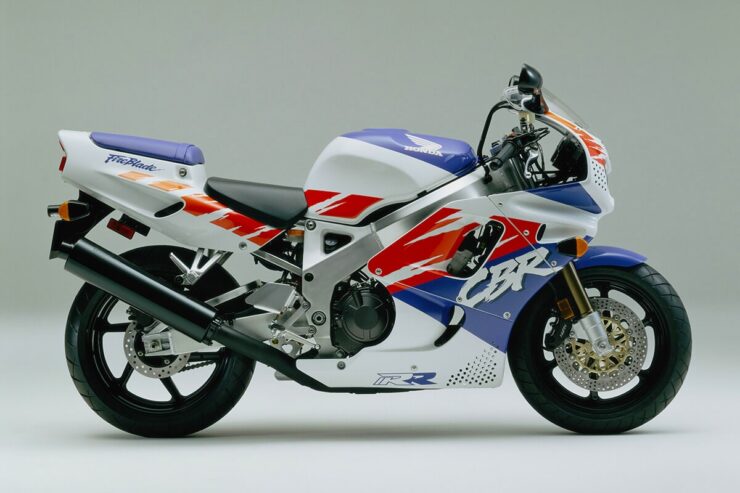

Honda engineer Tadao Baba took a different approach: instead of simply increasing horsepower, he focused on reducing mass and improving handling. The result was a 893cc inline-four that weighed just 185 kg dry – dramatically lighter than its competitors, and it transformed what riders expected from a superbike.
“Bikes at the time in the 1980s were very fast. WHOOSSH but they never turned like a race bike. You see, I wanted a bike that would be good into the corners, which produced good power and had good brakes. A sport bike should be controlled freely as to the rider’s wish. In this aspect, all the big monsters from the time were not good enough to be called a sports bike. Yes, they were fast, but, heavy and I thought they were quite dull.”
“The CBR900RR made its debut in 1992, but it took us more than three years of test and development to reach that point. We knew we must go back and start again with sports bikes. We wanted to give riders something over which they had ‘total control.” – Tadao Baba
Over the next decade, the Fireblade underwent several refinements. The second-generation model in 1994 introduced chassis tweaks and suspension upgrades. By 1996, it had received its first major displacement bump to 918cc, along with further frame and geometry changes.
In 2000, the Fireblade became the CBR929RR, adopting fuel-injection and an all-new aluminum frame. Two years later, the CBR954RR followed with more power and a lighter chassis, pushing the original Fireblade recipe even further – the ethos remained intact – a focus on sharp handling, an excellent power-to-weight ratio, and real-world rideability over spec-sheet dominance. Then came 2004 – and a reset.
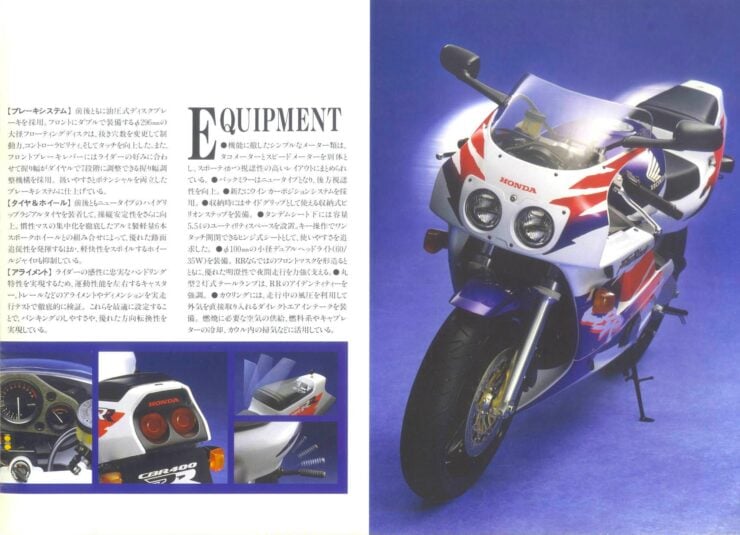


The 2004 model marked a turning point for the Fireblade lineage. Under the guidance of a new development team, the CBR1000RR was born, dropping the “Fireblade” branding in some markets but continuing its legacy.
This model was heavily influenced by Honda’s RC211V MotoGP machine, using the same Unit Pro-Link rear suspension, dual-stage fuel injection, and an all-new 998cc engine. It was longer, heavier, and more stable than its predecessors, reflecting a shift in Honda’s philosophy. Instead of chasing featherweight status, Honda aimed for balance across the board – power, handling, and predictability.
By 2005, the CBR1000RR had matured into a well-rounded and technically advanced superbike. Visually, it was largely unchanged from the 2004 model, but under the skin, Honda made a number of revisions aimed at refining the package.
These included updates to the suspension internals for improved feedback and responsiveness, as well as ECU remapping to improve throttle response. The 998cc inline-four engine produced a claimed 172 bhp at 11,250 rpm, paired with a smooth and linear torque curve that made it usable at road speeds, then brutal when fully wound out.
The engine had a dual-stage fuel injection (DSFI), a system that used two injectors per cylinder for more precise control of fuel delivery. The chassis was a MotoGP-influenced twin-spar aluminum frame mated to an inverted 43mm front fork and Honda’s Unit Pro-Link rear shock, both fully adjustable.
The underseat exhaust was not only a design statement but helped centralize mass, a major theme in MotoGP-inspired superbike development. Honda also employed an electronic steering damper (HESD), a novel feature at the time, which adjusted its damping force based on speed to balance low-speed maneuverability and high-speed stability.
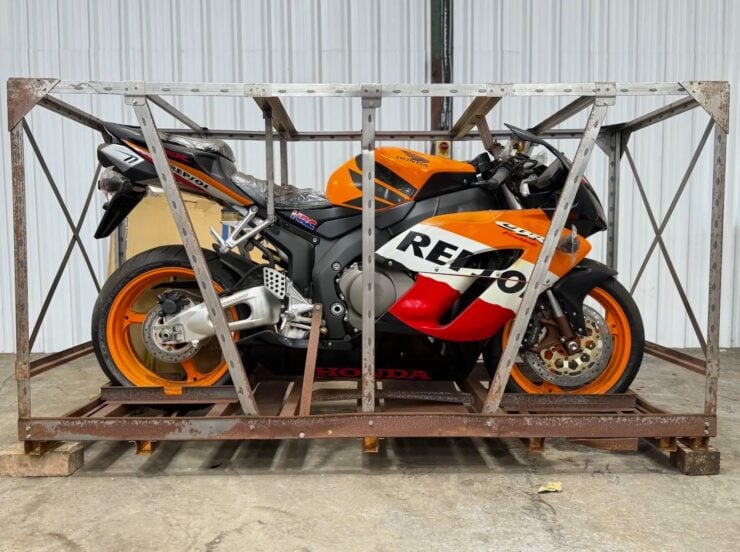


The 2005 Fireblade wasn’t the lightest or most powerful superbike on paper, but that was never its intent. It was engineered for control and predictability, which gave riders confidence to push harder. The power delivery was smoother than many of its rivals, and the handling felt stable and neutral, whether leaned over mid-corner or trail-braking into a tight bend.
In hindsight, the 2005 CBR1000RR marked a transition phase for Honda. It bridged the analog aggression of the early Fireblades with the increasingly technology-driven superbikes that would come to dominate the market in the 2010s.
The Fireblade was no longer just a wild-eyed canyon carver, it was becoming a refined performance machine built with racing pedigree and street sensibility in equal measure. For riders who wanted speed without drama, and engineering without gimmicks, the Fireblade offered a well-calibrated blend of both.
The 2005 Honda Fireblade Shown Here
The bike you see here is possibly unique in the world, in that it’s never been removed from its factory crate or ridden. Somehow it spent the last 20+ years in storage as ex-dealer stock, and it comes complete with an unopened box containing keys, screen, books and mirrors.
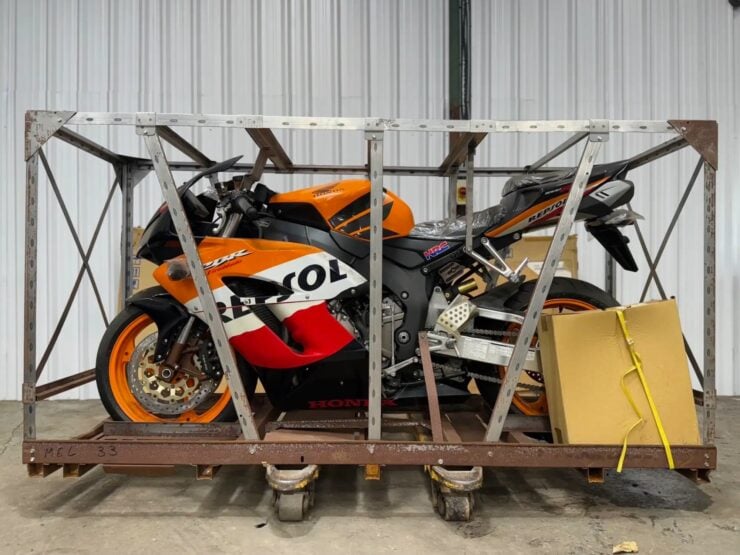


Many consider these earlier Fireblades to be a sweet spot in the history of modern superbikes, before the electronic rider aids began to get in the way. It will be up to the new owner whether they take this bike out of its crate and commission it for street riding, or if they leave it in the crate and preserve it as-is.
It’s now due to roll across the auction block with Iconic Auctioneers on the 29th of July with a price guide of £10,000 – £15,000 or approximately $12,700 USD – $19,050 USD. If you’d like to read more about it or register to bid you can visit the listing here.
Images courtesy of Iconic Auctioneers


